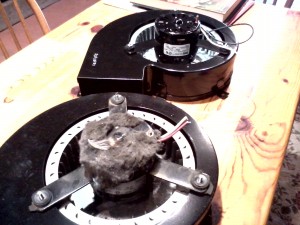Yes, it can happen. Typically, pellet stove chimneys get blocked by flyash, but this past season was not typical. This was a crazy winter and it brought on some unusual scenarios for pellet stove users because of the mild weather conditions. This mild weather resulted in smaller heating requirements and that is where a potential problem could begin with your pellet stove.
Remember, creosote can form in any wood fuel burning device. All you need are the proper conditions. When wood is burned, the products of combustion will combine with moisture and form a sooty residue. The moisture comes from condensation in the chimney pipe as well as from the fuel itself. This is creosote and it is more likely to be a problem in a pellet stove chimney where a small fire is being burned. This cooler fire allows for a lower chimney temperature and makes it easier for the smoke to attach itself to the chimney pipe in the form of creosote. If the pipe is not cleaned, a chimney fire is eminent.

Creosote Filled Pipe
Both above and below you can see the aftermath of a pellet stove chimney fire.

After chimney fire
These pictures are from a customers stove, and in this case the fire was contained inside the chimney and stove but the silicone gasketing that seals each piece of pipe was destroyed due to the extreme heat. As you can see in the above photo, the exterior of the rigid pellet vent was slightly discolored but otherwise safe to reuse. The stove contained it’s portion of the chimney fire and sustained only minor damage as well. We had to replace the stoves thermocouple in the exhaust tailpipe. Once the pipe was reinstalled, the stove functioned fine.
After consulting with the pellet stove owner, it was determined that the stove had been burned at a very low fire setting for several months. He was using the thermostat mode of operation and had it set for under 60 degrees F. Because of this, the stove had creosote build up in it, as well as in the exhaust pipe. He failed to recognize what it was and when he turned up the thermostat in January, he touched off all that creosote stored in the pipe and created a chimney fire.
There are many things you can do to avoid a chimney fire and it begins with recognizing creosote when you see it. Stage one creosote is flaky and dusty like black and grey corn flakes and can be easily removed by brushing the flue pipe. Stage two creosote is crunchy and shiny. It still crumbles but can have an gum like substance in it. It will require a more thorough brushing of the pipe and maybe even need scraping. Stage three creosote is glazed over, hard and sticky. When heated it can turn into a tar like substance that can drip. In all cases, it has a pungent odor and can be very dangerous. Immediate removal is required along with a review of your burning procedure. See these maintenance at this link. http://blazinghotstoves.com/trusted-services/maintenance/maintenance-tips/
To reduce creosote formation in your pellet stove you should burn it on at least 30% capacity or more while on. If it is a mild day and you don’t need much heat, it might be better to simply turn the stove on high until you are warm then shut it off until it is needed again. If you do choose to burn on a low setting for extended periods then you should periodically turn the pellet stove burn rate up to cook off any creosote deposits before they accumulate to dangerous levels. During a normal heating season, this is usually not a problem, but with the mild winter we had, we saw a large increase in creosote related problems. Rule of thumb says of if you burn 40 to 50 pounds of fuel or more in a 24 hour period with the stove running continually, you should not have a problem. When you drop below that amount and run the stove 24 hours a day, inspect you stove and exhaust.
Some stoves include an automatic thermostat in addition to a manual control system. An example of this system can be found in the Harman Accentra pellet stove and Harman Accentra Pellet Stove Insert that you can view from the following link. http://blazinghotstoves.com/quality-products/ The automatic thermostat is a fantastic feature but there are certain times when you may not want to use that mode of operation. One example is during milder weather, that’s when you are better off switching to manual operation, because if you use the stoves thermostat in milder weather it can force the stove into standby mode for much of the day. This is because every time the stove is triggered to shut off, it gets another heat call, which it quickly satisfies with a small fire. When it tries to shut off again it gets another call and this repeats itself all day. Again, this won’t be a problem if you burn the stove on high for an hour or two a day though. If you don’t, then the deposits will never burn off and could potentially cause problems later.
In addition, stoves such as the Vista Flame pellet stove, St Croix Pellet stove and Country Stoves Winslow PS40 Pellet stove have elaborate exhaust chambers inside the stove itself. These passages can get packed with creosote as well and due to limited access and poor design, can be almost impossible to clean properly if burned on low habitually.
So remember, If you want trouble free operation from your pellet stove, it is best to use high quality pellets and cycle your heat control up regularly to keep both your pellet stove and your chimney clean. Thanks for reading our blog!



